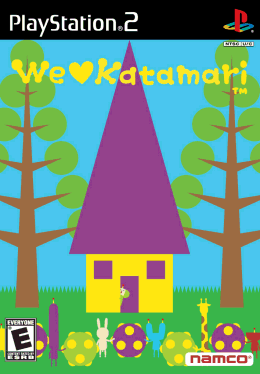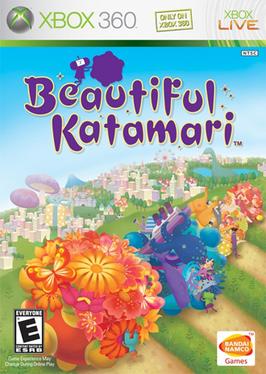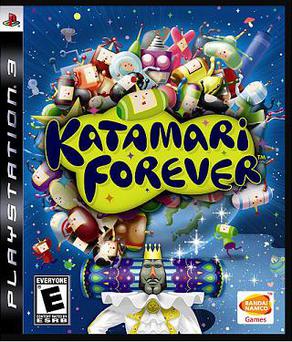
Katamari Damacy is a third-person puzzle-action video game developed and published by Namco for the PlayStation 2. It was released in Japan in March 2004 and later in North America in September. Designer Keita Takahashi struggled to pitch the game to Namco's superiors, eventually seeking student aid from the Namco Digital Hollywood Game Laboratory to develop the project for less than US$ 1 million. As director, Takahashi emphasized concepts of novelty, ease of understanding, and enjoyment.

We Love Katamari is a 2005 puzzle-action video game developed and published by Namco for the PlayStation 2. It is the sequel to the 2004 sleeper hit Katamari Damacy. The player controls a diminutive character named the Prince as he rolls around an adhesive ball called a "katamari" to collect increasingly larger objects, ranging from coins to pencils to buildings, in order to build stars as ordered by his father, the King of All Cosmos.

Pac-Attack, also known as Pac-Panic, is a 1993 falling-tile puzzle video game developed and published by Namco for the Super Nintendo Entertainment System and Sega Genesis. Versions for the Game Boy, Game Gear and Philips CD-i were also released. The player is tasked with clearing out blocks and ghosts without them stacking to the top of the playfield — blocks can be cleared by matching them in horizontal rows, while ghosts can be cleared by placing down a Pac-Man piece that can eat them. It is the first game in the Pac-Man series to be released exclusively for home platforms.

Keita Takahashi is a Japanese game designer and artist, his most notable titles being Katamari Damacy and its sequel, We Love Katamari. The original Katamari game was a surprise hit and was praised for its quirkiness, originality, and charm. Takahashi is married to pianist and composer Asuka Sakai, who has worked with Takahashi on various projects.

Beautiful Katamari, released in Japan as Beautiful Katamari Damacy, is a video game by Namco Bandai Games for the Xbox 360. Beautiful Katamari is the fourth game in the Katamari series of games following Katamari Damacy, We Love Katamari, and Me & My Katamari.
Katamari Damacy Mobile was a video game developed by Namco Bandai Games for the Mitsubishi P904i series of mobile phones for NTT Docomo. It was released in June 2007 in Japan. It is a spin-off of the Katamari Damacy series, the second game on a handheld game console and the third game produced without the involvement of series creator Keita Takahashi.

Doom is a 2016 first-person shooter video game developed by id Software and published by Bethesda Softworks. The game is the first major installment in the Doom series since 2004's Doom 3 and is a reboot of the franchise. It was released for PlayStation 4, Windows, and Xbox One in May 2016. A port for Nintendo Switch was co-developed with Panic Button and released in November 2017, and a version for Google Stadia was released in August 2020. Players take the role of an unnamed space marine, known as the "Doom Slayer", as he battles demonic forces within an energy-mining facility on Mars and in Hell.

NOISE Inc. is a Japanese video game development company that works in partnership with Nintendo, developing games for the Custom Robo series.

I Love Katamari was a third-person puzzle-action video game developed by Namco Bandai Games for iOS. It is a continuation of the Katamari Damacy series of games. It was released worldwide in the App Store on December 14, 2008. A Windows Phone 7 version of the game was released in 2010. The version for Android was released in 2012 exclusively for Samsung Android devices. In this game, the King of All Cosmos instructs the game's protagonist – the Prince – to gather as many objects as possible to grow a highly adhesive ball called a Katamari large enough so that he can pick up special objects to bring to the King so that he can regain his memory.

Katamari Forever, known in Japan as Katamari Damacy Tribute, is a video game in the Katamari series. The game was released for the PlayStation 3 console in Japan on July 23, 2009, and in September for North America, Europe, and Australia.

Muscle March, known in Japan as Muscle Kōshinkyoku, is an action game developed and published by Namco Bandai Games for the Wii through the WiiWare service. It was released in Japan in 2009, and in North America and the PAL region in 2010. Players control one of seven different bodybuilders and try to catch a thief that has stolen their bodybuilding friends' tub of protein powder. Its gameplay is similar to Hole In The Wall, where players use the Wiimote and Nunchuck to perform specific bodybuilder poses to pass through corresponding holes in walls left by the thief.
Katamari Damacy is a third-person puzzle-action video game that was published and developed by Namco for the PlayStation 2 video game console. The success of the game led to the release of six sequels in Japan and other territories: We Love Katamari, Me & My Katamari, Beautiful Katamari, Katamari Damacy Mobile, I Love Katamari, and Katamari Forever. It also inspired a spin-off game, Korogashi Puzzle Katamari Damacy.

Katamari is a Japanese video game franchise created by Keita Takahashi and developed and published by Namco. The series puts players in control of a young character called The Prince as he assists his father, the King of All Cosmos, in the re-creation of stars and planets by using a ball called a katamari to roll up objects. The first title in the series was Katamari Damacy for the PlayStation 2, which became a cult classic and led to several sequels and spin-offs.

Touch My Katamari, known in Japan as Katamari Damacy No-Vita, is a video game in the Katamari series. It was developed by Namco Bandai Games for the PlayStation Vita and was released as a launch game in Japan on December 17, 2011 and in Europe and North America on February 22, 2012.

Gamer Network Limited is a British digital media company based in London. Founded in 1999 by Rupert and Nick Loman, it owns brands—primarily editorial websites—relating to video game journalism and other video game businesses. Its flagship website, Eurogamer, was launched alongside the company. It began hosting the video game trade show EGX in 2008. ReedPop acquired Gamer Network in 2018 and sold it to IGN Entertainment in 2024.

Lovers in a Dangerous Spacetime is a space shooter video game developed by Asteroid Base for Microsoft Windows, OS X, PlayStation 4, Linux, Xbox One, and Nintendo Switch. The project is part of the ID@Xbox program. The game's title is a reference to the Bruce Cockburn song "Lovers in a Dangerous Time".

Clustertruck is a 2016 platformer game developed by the Swedish independent studio Landfall Games and published by tinyBuild. The game consists of nine worlds in which the player must navigate by jumping on moving trucks to avoid obstacles and the ground, culminating in a boss fight. This concept originated from Landfall Games's founder, Wilhelm Nylund, picturing himself leaping across trucks to escape traffic. Clustertruck was released for Linux, macOS, the PlayStation 4, Windows, and the Xbox One in September 2016, followed by a version for the Nintendo Switch in March 2018. While praised for its gameplay, graphics, and original soundtrack, Clustertruck's Nintendo Switch port was primarily criticized for its controls.
The live streaming of video games is an activity where people broadcast themselves playing games to a live audience online. The practice became popular in the mid-2010s on the US-based site Twitch, before growing to YouTube, Facebook, China-based sites Huya Live, DouYu, and Bilibili, and other services. By 2014, Twitch streams had more traffic than HBO's online streaming service, HBO Go. Professional streamers often combine high-level play and entertaining commentary, and earn income from sponsors, subscriptions, ad revenue, and donations.

Fallout 76 is a 2018 action role-playing video game developed by Bethesda Game Studios and published by Bethesda Softworks. It is an installment in the Fallout series and a prequel to previous entries. Initially set in the year 2102, players control a resident of Vault 76 who must venture out into the dilapidated open world known as "Appalachia" in order to re-colonize the region, and uncover a mysterious plague that has killed off its inhabitants.
Emulators of the Nintendo Switch, Nintendo's current eighth-generation video game console, have been in development since 2017, less than a year after the console's release. Multiple emulators have been in development, the most well-known being Yuzu and Ryujinx, both now defunct. Switch emulators have been widely noted by video games journalists for the swift and significant progress of their abilities to accurately emulate the console, as they are already able to run existing and new titles for the console in a playable state, sometimes within days of their release, as well as able to run on a variety of devices, including PCs running Windows and Linux, and the Steam Deck.
















